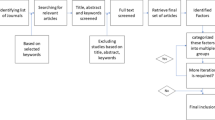Abstract
This paper presents the design, development and validation methodology of an agent-based computational model of the B2C electronic auction marketplace. It aims at a comprehensive understanding of the varied issues governing a B2C electronic auction, incorporating the behavior of all relevant agents such as the auctioneer, the consumer and the retailer; and the environment in which these agents operate and interact. In contrast with conventional methods, agent based modeling employs a bottom-up modeling approach where behaviors of individual agents and rules for their interaction, specified at the micro level, give rise to emergent macro level phenomenon. The development methodology should ensure that agent models are aligned with theory, current knowledge of the field and observed phenomena, and output validity of the model also needs to be ascertained. Beginning with a general introduction to agent based computational modeling, this paper formalizes this alignment and validation methodology and elaborates each step, noting the rationale and means for achieving these. The manner in which this process was used in modeling B2C auctions is then described.
Similar content being viewed by others
References
W.B. Arthur, J. Holland, B. LeBaron, R. Palmer and P. Tayler, Asset Pricing Under Endogenous Expectations in an Artificial Stock Market Model, in W.B. Arthur, S.N. Durlaf and D.A. Lane (Eds.), The Economy as a Evolving Complex System II (Reading, Addision-Wesley, MA, 1997)
R. Axtell, Why agents? On the varied motivations for agent computing in the social sciences (Working paper No. 17, Center on Social and Economic Dynamics, Brookings Institution, 2000)
R. Axtell, R. Axelrod, J.M. Epstein and M.D. Cohen, Aligning Simulation Models: A Case sof Study and Results, Computational Mathematical Organization Theory, 1(2) (1996) 123–141
R. Bapna, P. Goes and A. Gupta, Analysis and Design of Business-to-Consumer Online Auctions, Management Science, 49(1) (2003a) 85–101
R. Bapna, P. Goes and A. Gupta, Replicating Online Yankee Auctions to Analyze Auctioneers’ and Bidders’ Strategies, Information Systems Research, forthcoming, (2003b)
R. Bapna, A. Gupta and P. Goes, Comparative Multi-item Online Auctions: Evidence from the Laboratory, Decision Support Systems, 32(2) (2001) 135–153
R.F. Easley and R. Tenorio, Jump-Bidding in Internet Yankee Auctions (Working Paper, University of Notre Dame,2002)
J. Epstein and R. Axtell, Growing Artificial Societies: Social Science from the Bottom Up (MIT Press, Cambridge, 1996)
D. Hales, Artificial Societies, Theory Building and Memetics. Proceedings of 15th International Conference on Cybernetics (Belgium, Namur, 1998)
J.H. Kagel, Auctions: A Survey of Experimental Research, in J.H. Kagel and A.E. Roth (Eds.), Handbook of Experimental Economics, (Princeton University Press, Princeton, 1995)
J. Kephart, J.E. Hanson and J. Sairamesh, Price-War Dynamics in a Free Market Economy of Software Agents, Proceedings of Artificial Life VI Conference, UCLA, (June 1998)
J. Kephart, Software agents and the information economy. Proceedings of the National Academy of Sciences. Forthcoming, (2001)
B. LeBaron, Agent-based computational finance: Suggested readings and early research, Journal of Economic Dynamics and Control, 24, (2000) 679–702
K. Mehta and B. Lee, A Model of Market Interactions: Auctions vs. Posted Price, (Working Paper, University of Connecticut, 2003)
K. Mehta and B. Lee, Efficiency Comparison in Electronic Market Mechanisms: Posted-Price Versus Auction Market WISE Conference (Charlotte, NC, 1999)
A.E. Roth and A. Ockenfels, Last-Minute Bidding and the Rules for Ending Second-Price Auctions: Evidence from eBay and Amazon Auctions on the Internet. American Economic Review, forthcoming. (2002)
B. Stefansson, Swarm: An Object Oriented Simulation Platform Applied to Markets and Organizations, in P. Angeline, R. Reynolds, J. McDonnell andR. Eberhart (Eds.),Evolutionary Programming VI, Proceedings, Lecture Notes in Computer Science Vol. 1213, (Springer-Verlag, New York, 1997)
G. Stigler, The Economics of Information, Journal of Political Economic Theory, 69(3), (1961), 373–388
L. Tesfatsion, Economic Agents and Markets as Emergent Phenomena. in the Proceedings of the National Academy of Sciences, (November 12, 2001)
L. Tesfatsion, Agent-Based Computational Economics: Growing Economies from the Bottom Up, Artificial Life, 8(1), (2002)
Y. Vakrat and A. Seidmann, Can Online Auctions Beat Online Catalogs? Proceedings of the 20th International Conference on Information Systems, (Charlotte, NC. 1999)
R.T. Wilcox R.T., Experts and Amateurs: The Role of Experience in Internet Auctions, Marketing Letters, 11(4), 363–374, (2000)
M. Youssefmir, B.A. Huberman, et al., Bubbles and Market Crashes, Computational Economics, 12(2), (1998)
Author information
Authors and Affiliations
Corresponding author
Rights and permissions
About this article
Cite this article
Mehta, K., Bhattacharyya, S. Design, development and validation of an agent-based model of electronic auctions. Inf Technol Manage 7, 191–212 (2006). https://doi.org/10.1007/s10799-006-9182-3
Issue Date:
DOI: https://doi.org/10.1007/s10799-006-9182-3



